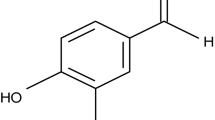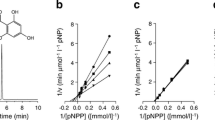Abstract
The insulin signalling pathway consists of a series of phosphorylation and dephosphorylation steps inside the target cell. Phosphotyrosine phosphatase 1B (PTP1B) dephosphorylates phosphotyrosine (pTyr) residues present on the insulin receptor (IR). In this study we examined the effect of bis(maltolato)oxovanadium(IV) (BMOV) on PTP1B and its possible role in the amelioration of insulin resistance. Fourteen to sixteen week old fatty Zucker rats (F), an animal model of insulin resistance, were treated with BMOV in drinking water for 3 weeks (FT) along with age matched lean littermate controls. The fatty rats responded to vanadium with a significant decrease in plasma insulin, (F = 5.1 ± 0.8 FT = 3.3 ± 0.7 ng/ml). During insulin resistance the activity of PTP1B has been shown to increase, thus diminishing insulin signalling in the target tissues. Hence, PTP1B is an important target for anti-diabetic drug research. In our investigation we found that the PTP1B activity was increased to 200% in the skeletal muscle of untreated Zucker fatty rats compared to lean littermates. Three weeks of BMOV treatment reduced the activity of PTP1B by 25% in fatty treated rats, in vivo, compared to untreated fatty rats. There was no significant change in the activity of PTP1B in the lean treated rats. There was also no difference in the gene expression of PTP1B in the skeletal muscle of different groups of rats. Vanadium compounds also inhibited PTP1B in vitro. These results indicate that PTP1B may be a potential target for the action of BMOV at least in the Zucker fatty rat model.
Similar content being viewed by others
References
Kahn BB: Type 2 diabetes: When insulin secretion fails to compensate for insulin resistance. Cell 92:593–596, 1998
Avruch J: Insulin signal transduction through protein kinase cascades. Mol Cell Biochem 182: 31–48, 1998
Salmeen A, Andersen JN, Myers MP, Tonks NK, Barford D: Molecular basis for the dephosphorylation of the activation segment of the insulin receptor by protein tyrosine phosphatase 1B. Mol Cell 6: 1401–1412, 2000
Ahmad F, Goldstein BJ: Increased abundance of specific skeletal muscle protein tyrosine phosphatase in a genetic model of insulin resistant obesity and diabetes mellitus. Metabolism 44: 1175–1184, 1995
Elchebly M, Payette P, Cromlish W, Collins S, Loy AL, Normandin D, Cheng A, Himms-Hagen J, Chan C-C, Ramachandran C, Gresser M, Trembley ML, Kennedy BP: Increased insulin sensitivity and obesity resistance in mice lacking the protein tyrosine phosphatase 1B gene. Science 283:1544–1548, 1999
Heyliger CE, Tahiliani AG, McNeill JH: Effect of vanadate on elevated blood glucose and depressed cardiac performance of diabetic rats. Science 227: 1474–1477, 1985
Poucheret P, Verma S, Grynpas MD, McNeill JH: Vanadium and diabetes. Mol Cell Biochem 188: 73–80, 1998
Huyer G, Liu S, Kelly J, Moffat J, Payette P, Kennedy B, Tsaprailis G, Gresser MJ, Ramachandran C: Mechanism of inhibition of proteintyrosine phosphatases by vanadate and pervanadate. J Biol Chem 272: 843–851, 1997
Foulkes J, Jefferson LS: Protein phosphatase-1 and-2A activities in heart, liver, and skeletal muscle extracts from control and diabetic rats. Diabetes 33: 576–579, 1984
Laemmli UK: Cleavage of structural proteins during the assembly of the head of the bacteriophage T4. Nature 227: 680–685, 1970
Pugazhenti S, Tanha F, Dahl B, Khandelwal RL: Decrease in protein tyrosine phosphatase activities in vanadate-treated obese Zucker (fa/fa) rat liver. Mol Cell Biochem 153: 125–129, 1995
Setyawati IA, Thompson KH, Yuen VG, Sun Y, Battell M, Lyster DM, Vo C, Ruth TJ, Zeisler S, McNeill JH, Orvig C: Kinetic analysis and comparison of uptake, distribution, and excretion of 48V-labelled compounds in rats. J Appl Physiol 84: 569–575, 1998
Mohammad A, Bhanot S, McNeill JH: In vivo effects of vanadium in diabetic rats are independent of changes in PI-3 kinase activity in skeletal muscle. Mol Cell Biochem 223: 103–108, 2001
Marzban L, Bhanot S, McNeill JH: In vivo effects of bis(maltolato)-oxovanadium (IV) on PKB activity in the skeletal muscle and liver of diabetic rats. Mol Cell Biochem 223: 147–157, 2001
Semiz S, Orvig C, McNeill JH: Effects of diabetes, vanadium and insulin on glycogen synthase activation in Wistar rats. Mol Cell Biochem 2002 (in press)
Author information
Authors and Affiliations
Corresponding author
Rights and permissions
About this article
Cite this article
Mohammad, A., Wang, J. & McNeill, J.H. Bis(maltolato)oxovanadium(IV) inhibits the activity of PTP1B in Zucker rat skeletal muscle in vivo . Mol Cell Biochem 229, 125–128 (2002). https://doi.org/10.1023/A:1017984930836
Issue Date:
DOI: https://doi.org/10.1023/A:1017984930836




